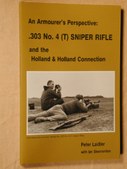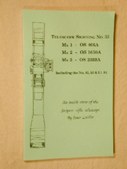-
FREE MEMBER
NO Posting or PM's Allowed

No#4 1944 T CDN Long Branch Lee Enfielld Sniper scope with spider optics?
Hi
I am looking at a 1944 T Long Branch Lee Enfield that has a matching scope with Spider sites inside the scope?
Is this a scope that is rare or never existed?
Thanks
Adam
adameveringham@hotmail.com
Information
 |
Warning: This is a relatively older thread
This discussion is older than 360 days. Some information contained in it may no longer be current. |
|
-
02-18-2011 07:03 PM
# ADS
Friends and Sponsors

-
Am I the only one who doesn't understand the question?
What are spider sites
if it exists, and you've got it, how did it never exist?
-
-
Am I the only one who doesn't understand the question?
What are spider sites
I think it may refer to this in the Wikipedia definition of a reticle, but I'm not sure … 
 Reticle
Reticle
Wire crosshairs
The original crosshairs in fact used hair or spiderweb, as it was thin and strong. Many modern scopes use wire crosshairs, which can be flattened to various degrees to change the width. These wires are usually silver in color, but appear black when backlit by the image passing through the scope's optics. Wire reticles are by nature fairly simple, as they require lines that pass all the way across the reticle, and the shapes are limited to the variations in thickness allowed by flattening the wire; duplex crosshairs, and crosshairs with dots are possible, and multiple horizontal or vertical lines may be used. The advantage of wire crosshairs is that they are fairly tough and durable, and provide no obstruction to light passing through the scope.
Regards,
Doug
-
-
FREE MEMBER
NO Posting or PM's Allowed

Am I the only one who doesn't understand the question?
What are spider sites
if it exists, and you've got it, how did it never exist?
Quite simple really, is it a fake or were their any scopes made, that did not have the usual type if pattern inside the scope. I am being told this is a rare scope with a different type of siting view than the standard CDN REL.
Thanks
---------- Post added at 06:11 AM ---------- Previous post was at 06:09 AM ----------

Originally Posted by
Badger

I think it may refer to this in the Wikipedia definition of a , but I'm not sure …

Regards,
Doug
Yes reticle.
---------- Post added at 06:17 AM ---------- Previous post was at 06:11 AM ----------

Originally Posted by
Rajeee

Quite simple really, is it a fake or were their any scopes made, that did not have the usual type if pattern inside the scope. I am being told this is a rare scope with a different type of siting view than the standard CDN REL.
Thanks
---------- Post added at 06:11 AM ---------- Previous post was at 06:09 AM ----------
Yes reticle.
It would appear that you actually understand what I am asking. Was their any rare scopes or prototypes used on Long Branch No #4 T.
Thanks
-

Originally Posted by
Rajeee

Quite simple really, is it a fake or were their any scopes made, that did not have the usual type if pattern inside the scope. I am being told this is a rare scope with a different type of siting view than the standard CDN REL.
I've never heard of it, or seen any references to this in any published material.
Before I'd even consider buying anything like that with those claims, I'd ask the seller for pics of the scope, or other visual content which could be examined by the many expert Enfield authors and collectors here to see if there is any veracity to his claims ... 
Regards,
Doug
-
-
It would appear that you actually understand what I am asking. Was their any rare scopes or prototypes used on Long Branch No #4 T.
Thanks
PM sent re this/your comment.....................
But yes, there were other variations of grat pattern in versions of the No32
-
-
FREE MEMBER
NO Posting or PM's Allowed


Originally Posted by
Badger

I've never heard of it, or seen any references to this in any published material.
Before I'd even consider buying anything like that with those claims, I'd ask the seller for pics of the scope, or other visual content which could be examined by the many expert Enfield authors and collectors here to see if there is any veracity to his claims ...

Regards,
Doug
Thank you for your assistance I am going to look at this gun today. I just wondered as to what the unusal optics might be that he was referring too.
'Spider optics" is the term he used, not mine.
I suppose I will know when I see it.
Adam
-

Originally Posted by
Rajeee

Thank you for your assistance I am going to look at this gun today. I just wondered as to what the unusal optics might be that he was referring too.
'Spider optics" is the term he used, not mine.
I suppose I will know when I see it.
Adam
I had never heard the term before, but it's an interesting phrase ... 
In addition to being a trained and highly experienced military Armourer, Peter Laidler has authored two excellent books about the No.4(T) sniper rifles and their No.32 scopes. They are titled "An Armourer's Perspective: .303 No.4(T) Sniper Rifle", which he co-authored with Ian Skennerton
has authored two excellent books about the No.4(T) sniper rifles and their No.32 scopes. They are titled "An Armourer's Perspective: .303 No.4(T) Sniper Rifle", which he co-authored with Ian Skennerton and his own dedicated work, "Telescope Sighting No.32".
and his own dedicated work, "Telescope Sighting No.32".
If you're really interested in some in-depth learning about the No.4(T) sniper rifles and the No.32 series of scopes, their history, evolution, repair and adjustments for shooting, we'd highly recommend those two books, which are pictured below.
 (Click PIC to Enlarge)
(Click PIC to Enlarge)
Regards,
Doug
-
-
Incidentally, the other grat patterns that you can occasionally find in No32 variants are 'fairly' easy to replace back to the ususl spec so please don't be put off by one that has a different grat/reticle pattern.
I say 'fairly' easy........... That's 'fairly' easy if you have the riught kit but it can be done
-
-
Sounds like you have the reticule from a 71 scope. I've replaced a few and most seem to come from "down under"
drop me a PM if you want it changed..
-
The Following 2 Members Say Thank You to Warren For This Useful Post:















 Register To Reply
Register To Reply
















